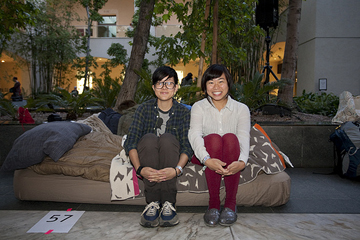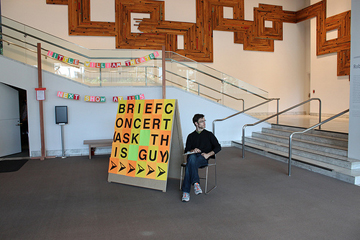On a recent weekend at the Hammer Museum, you may have stumbled across other visitors napping on the gallery floor and wondered if they had succumbed to museum fatigue. In fact, they were participating in a Nap-in hosted by Artist-in-Residence Machine Project in conjunction with Adam Overton for the Hammer’s special exhibition of Carl Jung’s Red Book. One of Machine Project’s long-time collaborative partners, Adam Overton is an experimental sound artist, composer, and massage therapist whose recent work with ArtSpa explores different forms of intimacy and meditative consciousness. The Nap-in at the Hammer followed a Dream-in held the previous night: visitors slept over at the museum and recorded interviews about their dreams the next morning. Throughout the day, volunteers reenacted scenarios from the dreams in the gallery, while a video of dream interviews played downstairs in the lobby. Museum-goers could participate, watch, or just glance and pass by any of these activities. However they if chose to engage, they were offered a different experience than simply walking past an art object encased in glass. The Dream-in provided an opportunity for visitors to connect the Jungian notion of a collective unconscious with their own dream recollections.
For the Hammer, Machine Project’s residency is the start of a new visitor engagement and education program, reflected upon by Hammer Museum Director Ann Philbin in the Summer 2010 issue of Artforum. Machine Project is spending this year at the Hammer, investigating and expanding the ways that visitors negotiate the social space created by the museum’s structure and the impact it has on their aesthetic experience. The collaboration aims to foreground the museum as forum for conversation about art, as well as to be a cultural repository.
I founded Machine Project in 2003 at a storefront gallery in Echo Park, Los Angeles, because I wanted to create an informal public space for intellectual and artistic community. When I think about the question of how we experience art, I am specifically interested in how we experience through art — the perspective that an object or technology offers on the world. The concept of art functions to open up a flexible, permissive sphere in which people can re-imagine the way their immediate reality is structured — an ambulatory thought bubble in which possibilities materialize.
The Hammer residency is the most recent of several institutional collaborations Machine Project has done over the past years, including work with the Los Angeles County Museum of Art (LACMA), the Contemporary Art Museum St. Louis, and the Pomona College Museum of Art. Machine Project’s explorations of the museum as a specific context for viewing art draws on our interest in interrogating structural boundaries – between individual and institution, audience and performer, amateur and expert. As a Professor of Art at Pomona College as well the Director of Machine Project, I approach my work with the conviction that complex content can be made accessible and engaging if it is presented with enthusiasm, and if it offers multiple perspectives from which it can be approached. Machine Project facilitates collaborations among artists who treat audience experience as a primary facet of the work. This reflects a wider trend in which cultural institutions are increasingly interested in curating the experience of art, as well as the art objects.
This convergence of art and pedagogy and a shift toward greater participation has occurred over the past few decades, and finds an important public space in the art museum. The rules and customs of the museum as a cultural institution have traditionally tended to frame visitor experience as one of quiet contemplation and measured distance in relation to art objects. Machine Project’s interventions reveal this as one mode of approaching and valuing art, and suggest other kinds of less formal encounters. Our challenge at the Hammer is to develop projects that propose other ways of experiencing the museum that can be smoothly integrated into its everyday operation. For example, we are holding a needlepoint therapy group in the portrait gallery with psychologist Dr. Ellen Medway. Over the course of several weeks, participants develop a more personal and kinesthetic connection to their chosen painting, while at the same time sharing a social experience in the gallery. Other projects focus on spaces that are typically marked as non-spaces, such as the Little William Theater we have set up in the lobby coat closet. Intimate performances held there, for audiences of one or two, induce a giddy uncertainty about where the aesthetic experience is located and what constitutes that experience.
In a previous collaboration with LACMA in 2008, we took over the museum for a single day, producing over sixty events in a sort of burst of possibility. The Machine Project Field Guide to LACMA, conceived as a one-time occurrence, opened up conversation about the museum as an arbiter of cultural value and invited visitors to engage with the terms of that discourse, including questions of authenticity and appropriation. Under the guidance of artist Liz Glynn, some visitors created papier-mâché replicas of ancient vases and snuck them in the classical sculpture gallery next to the originals. A guitarist stood under a fake Gothic arch, constructed on the President’s balcony patio by Christy McCaffrey and Sara Newey, and played speed metal for one minute every hour. The performance functioned as a town clock, drawing visitors together for a moment before they dispersed again to return to their individual activities. The sheer density of things going on invited visitors to join in the spirit of “what if” that had served as the backbone of the planning process for Machine and its artist collaborators. LACMA visitors that day experienced the museum as a site of invention: the collection offered material that acted as a kind of springboard for idea generation, as well as enduring products for aesthetic appreciation.
In all of our institutional collaborations, we expand the museum’s role as a place that preserves valuable cultural artifacts into a site of possibility in which each work of art may be taken as a proposition, inviting the viewer to allow it, for a moment, to re-frame the world.
Mark Allen is an artist and Director of Machine Project, located in Los Angeles, CA.




